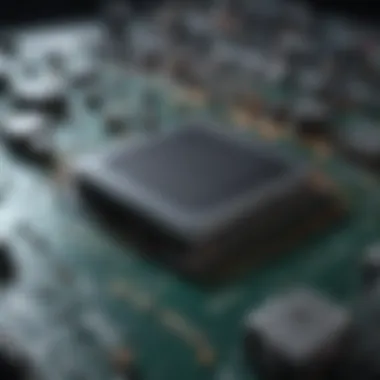Effective Troubleshooting Guide for TV Volume Issues Not Working Properly


Product Overview
When dealing with volume issues on your television set, it is imperative to understand the root causes impacting its functionality. A comprehensive troubleshooting guide becomes essential to navigate through the intricacies of resolving such common yet often vexing problems. This article aims to equip you with practical solutions, spanning from the rudimentary checks to the more intricate troubleshooting steps, ensuring a seamless viewing experience on your trusted TV screen.
Performance and User Experience
In the realm of television technology, performance benchmarks serve as crucial metrics to gauge the efficacy of audio output. Understanding the user interface and software capabilities enhances one's grasp of maximizing the volume settings. User experiences and feedback play a pivotal role in refining the user interface to deliver a seamless viewing experience, free from volume-related discrepancies.
Comparison with Previous Models or Competitors
Analyzing advancements and improvements from previous TV models provides a blueprint for progress. Competitive analysis enables us to discern the value proposition offered by each product. In the landscape of cutting-edge technology, staying abreast of the latest features distinguishes high-quality television sets from the competition.
Tips and Tricks
Unlocking the full potential of your television set requires adeptness in navigating through how-to guides and tutorials. Discover hidden features and functionalities that can amplify your viewing pleasure. Troubleshooting common issues surrounding volume discrepancies empowers you to address technical hitches promptly.
Latest Updates and News
Keeping abreast of recent software updates and new features ensures your television stays relevant in the fast-evolving tech sphere. Industry news and rumors surrounding upcoming products offer a sneak peek into the future of television innovation. Events and announcements from leading brands like Apple pave the way for an enriching viewing experience.
Introduction to Volume Problems on TV
In this insightful article, we delve into the vexing realm of volume-related issues encountered while trying to enjoy television content. The ability to control volume seamlessly impacts our viewing experience, highlighting the crucial role of understanding and troubleshooting such discrepancies. Amidst the complexities of modern television technology, grasping the nuances of volume irregularities emerges as paramount. By dissecting this topic, we equip readers with invaluable knowledge to navigate through potential hurdles.
Understanding the Issue
Identifying the nature of the volume problem:


Exploring the intricacies of volume malfunction unveils a pivotal layer within the television troubleshooting landscape. By discerning the specific root cause behind erratic volume behavior, individuals equip themselves with actionable insights. This meticulous approach not only aids in promptly rectifying issues but also fosters a deeper comprehension of the underlying mechanisms. Emphasizing this aspect underscores its significance in fostering a more profound troubleshooting experience within the domain of TV technology.
Factors affecting volume functionality:
Delving into the diverse factors that influence volume functionality sheds light on the multifaceted nature of this predicament. From external interferences to internal glitches, the landscape of volume functionality appears intricate yet methodical. Understanding the key aspects that sway volume performance elucidates the need for a comprehensive approach when addressing these challenges. By unraveling the labyrinth of factors impacting volume functionality, individuals arm themselves with the requisite knowledge to navigate through potential hurdles effectively.
Importance of Addressing the Problem
Impacts on viewing experience:
The perceptible impacts of unresolved volume issues reverberate throughout the viewing experience, disrupting the immersive nature of audio-visual content consumption. This section delves into the nuanced implications of untreated volume irregularities, underscoring the pivotal role of seamless volume functionality in achieving an optimal viewing ambiance. By elucidating these impacts, readers gain a holistic understanding of the transformative potential that addressing volume problems entails.
Possibility of underlying technical issues:
Peering beneath the surface of volume disruptions unveils the intricate web of technical anomalies that may underpin such discrepancies. By illuminating the potential technical snags that could be at the crux of volume malfunctions, individuals are urged to adopt a methodical and systematic approach toward issue resolution. Acknowledging the prospect of underlying technical intricacies empowers readers to navigate through troubleshooting endeavors armed with a heightened sense of awareness and precision.
Basic Troubleshooting Steps
As we delve into the realm of resolving volume issues on your television, understanding the significance of basic troubleshooting steps is crucial. These steps serve as the foundation for identifying and addressing common problems that may arise with the volume functionality. By focusing on basic troubleshooting, we can efficiently tackle issues before they escalate, ensuring a seamless viewing experience for the users. When it comes to basic troubleshooting, meticulous attention to detail and systematic checks can often unveil simple solutions to seemingly complex problems. Therefore, in this article, we emphasize the essence of basic troubleshooting steps as the initial approach to rectifying volume issues on your TV.
Volume Controls and Settings
Checking remote control settings
Discussing the specific aspect of checking remote control settings is paramount in the context of troubleshooting TV volume issues. This step involves verifying the configuration and functionality of the remote control, ensuring that it is properly synced with the TV. By examining the remote control settings, users can determine if any adjustments are necessary to regulate the volume effectively. The key characteristic of checking remote control settings lies in its ability to isolate control-related issues that may be affecting the volume output. This method is popular for its simplicity and accessibility, offering a straightforward way to diagnose and potentially resolve volume problems on the TV. However, it is essential to note that certain limitations, such as signal interference or battery issues, may impact the efficacy of this troubleshooting step within the context of the article.
Adjusting volume on TV itself


When focusing on adjusting the volume directly on the TV, we encounter a fundamental yet practical solution to volume irregularities. This approach allows users to bypass potential remote control malfunctions and directly manipulate the volume settings on the TV interface. The unique feature of adjusting volume on the TV itself lies in its autonomy from external factors, providing a direct route to modifying volume levels. While this method offers a hands-on approach to addressing volume issues, it may also have limitations, such as restricted volume range or technical constraints depending on the TV model. The advantages of this technique include immediate feedback on volume adjustments and the elimination of remote-related complications, making it a convenient choice for troubleshooting volume problems effectively in the context of this article.
Connections and Cables
Ensuring cables are properly connected
The aspect of ensuring cables are properly connected plays a critical role in troubleshooting TV volume issues, especially concerning audio connectivity. This step involves inspecting the physical linkage between the TV, audio devices, and external sources to verify seamless audio transmission. By confirming that all cables are securely connected and undamaged, users can preemptively address potential audio disruptions that may arise from loose connections or cable faults. The key characteristic of ensuring cable integrity lies in its capacity to mitigate audio distortions or interruptions caused by faulty connections, thereby optimizing the audio output for an enhanced viewing experience. This method is beneficial for its simplicity and direct correlation to audio quality, offering users a straightforward way to address volume-related issues linked to cable connectivity effectively within the scope of this article.
Testing audio inputs
Conducting tests on audio inputs is a pivotal troubleshooting step when encountering volume discrepancies on a TV. This process involves assessing the functionality of audio inputs by connecting different devices or sources to the TV audio ports. By testing various audio inputs, users can identify potential issues relating to input compatibility or source settings that may influence the volume output. The key characteristic of testing audio inputs lies in its ability to broaden the diagnostics scope beyond the TV unit itself, encompassing external factors that may impact volume performance. This method is popular for its comprehensive approach to troubleshooting, offering insights into cross-device compatibility and audio signal integrity. However, it is essential to consider the limitations of this method, such as device-specific configurations or audio format compatibility, when applying it to address volume problems effectively within the context of this article.
Advanced Troubleshooting Methods
In this intricate and comprehensive guide to resolving volume issues on TVs, the Advanced Troubleshooting Methods section stands out as a crucial aspect. This section delves deep into complex solutions beyond the basic fixes, offering readers a more in-depth understanding of potential technical issues and their resolutions. By focusing on Advanced Troubleshooting Methods, readers can elevate their troubleshooting skills and address intricate problems effectively.
Software Updates and Firmware
Checking for available updates
When addressing volume issues on a TV, checking for available updates emerges as a pivotal step in the troubleshooting process. This method involves exploring the TV's software for any pending updates that could potentially resolve volume-related bugs or glitches. The essence of checking for available updates lies in ensuring that the TV's operating system is up-to-date, thereby optimizing its performance and rectifying any underlying issues. By actively engaging in this process, users can enhance the TV's functionality and mitigate volume problems more effectively.
Updating TV firmware
Updating the TV firmware is a decisive action in tackling volume problems, contributing significantly to the overall troubleshooting goal. By updating the TV's firmware, users can access the latest enhancements and bug fixes provided by the manufacturer. This proactive approach not only improves the TV's performance but also addresses any firmware-related issues that may impact volume functionality. Despite the advantages of updating TV firmware, users should exercise caution as it may occasionally lead to compatibility issues with certain applications or settings. However, the benefits of updated firmware outweigh the potential drawbacks, making it a valuable choice in troubleshooting TV volume problems.
Audio Settings and Equalization


Adjusting audio settings for optimal performance
Fine-tuning audio settings for optimal performance plays a vital role in resolving volume issues on TVs. By adjusting audio settings such as volume levels, equalization, and sound modes, users can customize their audio output to suit their preferences and maximize viewing experience. The key characteristic of adjusting audio settings lies in its ability to address volume discrepancies, ensuring a balanced and immersive sound output. This feature is especially beneficial in this troubleshooting context as it empowers users to tailor the audio output to match their specific preferences, thereby enhancing the overall viewing experience.
Utilizing equalizer settings
Utilizing equalizer settings presents an advanced approach to optimizing audio output on TVs, contributing significantly to the troubleshooting process. By leveraging equalizer settings, users can adjust specific frequency bands to fine-tune the audio quality according to their preferences. This unique feature allows for precise control over the audio output, enabling users to customize the sound signature to align with their listening preferences. While utilizing equalizer settings offers enhanced audio personalization, users should consider the potential disadvantages such as inadvertently distorting sound quality if not adjusted properly. Overall, the benefits of utilizing equalizer settings in troubleshooting TV volume problems outweigh the minor drawbacks, making it a valuable tool for audio optimization.
Speaker Configuration
Testing speaker outputs
Testing speaker outputs is a fundamental step in diagnosing and resolving volume issues on TVs, playing a crucial role in the troubleshooting process. By testing speaker outputs, users can identify any potential hardware malfunctions or configuration errors that may impede volume functionality. The key characteristic of testing speaker outputs lies in its ability to pinpoint specific audio output issues, enabling users to address them promptly. This feature is particularly beneficial in this article as it provides a practical method for users to verify the integrity of their speaker setup and ensure optimal audio performance.
Calibrating audio settings
Calibrating audio settings serves as a pivotal aspect of optimizing audio performance on TVs, contributing significantly to the troubleshooting process. By calibrating audio settings, users can fine-tune various audio parameters such as sound levels, speaker distances, and audio delays to achieve optimal sound quality. The key advantage of calibrating audio settings is its capacity to tailor the audio output to suit the viewing environment and personal preferences, enhancing the overall audio experience. Despite the potential disadvantages associated with incorrect calibration leading to suboptimal audio quality, the benefits of calibrating audio settings in troubleshooting TV volume issues make it an essential step in resolving audio-related problems.
Professional assistance goes far beyond one's independent troubleshooting. In the realm of television volume issues, seeking expert guidance can be a game-changer. Professional Assistance and Further Resources serve as guiding lights in the labyrinth of technical maladies that often plague electronic devices. This section emphasizes the critical role of industry experts, customer support avenues, warranties, and online tech communities. It elucidates the multifaceted benefits, considerations, and nuances of availing professional aid and tapping into comprehensive resources, addressing volume incongruities effectively and efficiently. Offering a pathway to resolve issues beyond basic troubleshooting, professional assistance becomes a beacon of hope for those navigating the turbulent waters of TV malfunctions.
Conclusion
Volume issues on TV not working can significantly impact one's viewing experience and must be addressed promptly for optimal functionality. In this troubleshooting guide, readers have gained insights into identifying and rectifying volume problems effectively. By understanding the key factors influencing volume functionality, individuals can take necessary steps to ensure a seamless viewing experience. Timely resolution of volume issues is paramount, as it prevents further deterioration and enhances overall audio quality. Furthermore, proactive maintenance plays a crucial role in sustaining optimal TV performance and prolonging the lifespan of audio components. By following the prescribed measures outlined in this article, readers can navigate volume challenges with confidence, fostering a more enjoyable viewing experience.
Final Thoughts on Troubleshooting TV Volume
Emphasizing the importance of timely resolution
Emphasizing the significance of addressing volume issues promptly is vital in restoring audio balance and clarity. Timely intervention prevents the exacerbation of underlying technical problems, safeguarding the TV's audio system from potential damage. The proactive approach of addressing volume issues promptly ensures uninterrupted entertainment and spares users from extended periods of audio disruption. By prioritizing timely resolution, individuals safeguard their viewing experience and optimize the performance of their TV's audio output, ultimately enhancing their overall satisfaction.
Encouraging proactive maintenance for optimal performance
Proactive maintenance fosters a proactive attitude towards ensuring the long-term reliability and performance of a TV's audio system. By implementing regular checks and adjustments, users can preemptively identify and resolve emerging volume issues before they escalate. This preventive approach not only ensures consistent audio quality but also extends the longevity of the TV's audio components. Encouraging proactive maintenance empowers users to take control of their viewing experience, promoting a sense of ownership and engagement in optimizing their audio setup. By incorporating proactive maintenance as a regular practice, individuals invest in the sustained excellence of their TV's audio performance, reaping long-term benefits and enhanced viewing satisfaction.



